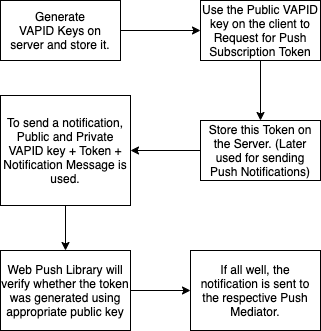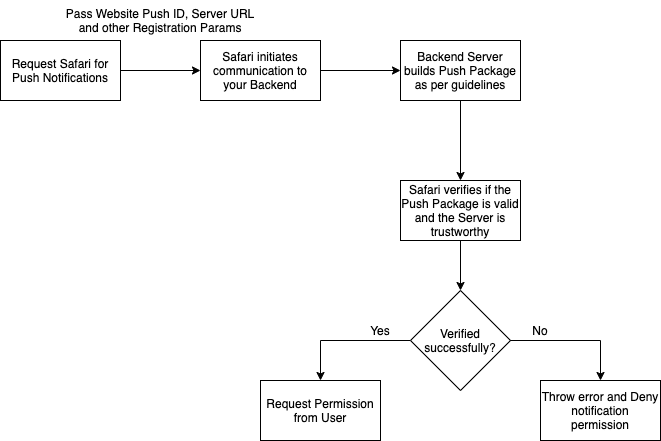An Interest In:
Web News this Week
- April 23, 2024
- April 22, 2024
- April 21, 2024
- April 20, 2024
- April 19, 2024
- April 18, 2024
- April 17, 2024
Web Push Notifications-explained!
Hello humans of Dev.to This is my first post here. Let's go!
In this article, we are targeting 3 major Browser Platforms for understanding Push Notifications in Web - Chrome, Firefox & Safari .
Functionally, Chrome & Firefox are very similar. Safari is an odd one because of restrictions from Apple (We know how Apple is when it comes to Security Standards overall)
Let's understand the basic flow of how the Notification works in Chrome/Firefox and Safari.
Chrome/Firefox Notifications:
Understanding a couple of terms here:
- Service Worker: A worker for your Website that keeps listening for background events, like "Push Notification Received". An example of a Push service worker:
- Subscription Token: A unique per Browser Token which is later used to target a Notification. This token has an expiry, so you might need to request a new one after some time. An example of what a token looks like:
{ "endpoint": "https://fcm.googleapis.com/fcm/send/ckjznRm-rKg:APA91bEs6ZqaooqA5CWnd9LXI1VwpfmQzUFdS_mpNYl8qaSF4WwvCe1h2QVrTYDINEPC0oZIQlYpnYBXx2BiPkORIA4U27pze1JkS0dz7o1kfzWkc5_md5uYnZUvwpyFyvPkoeIlYtMj","userAuth": "gpq2UFvdWkyomEWdbJ6n3w==","userPublicKey": "BNUOw0iXWjfGaIb7Q77jQaWAra72ga1Y1QHZ+g3TuBuwSr0gS0GMtP2BS/lYNGMwku8sJ4e3esChQHigVKFHnsY="}This all may look a bit complicated to implement if you are new to all this. Worry not, I have created a helper plugin for making your lives simpler- here's the link to the easy-web-notifications.
Just do npm install easy-web-notifications and follow the instructions in the README and you're all set-from requesting User for Notification Permission to getting the Subscription Token.
Safari Notifications:
In the case of Safari, there is no notion of Service Workers. Rather, Safari handles the delivery of Notifications on its own.
But here's is the weird part, you cannot directly request for Notification Permission from Safari. No no no no no
Understanding vocabulary:
- Website Push ID: It is an identifier for your Web App. If your Web App is hosted as
https://www.mywebapp.comthen your Website Push ID will beweb.com.mywebapp. This is a convention and not a rule. Please note, you cannot test Safari Notifications on the local environment, it needs to be published with HTTPS enabled. - Server URL: This is the URL of your Backend Server. It needs to be HTTPS and it also needs a valid certificate from a trusted authority (Self Signed certificates won't work)
- Registration Params: This is the extra params that you need to pass to your backend server to register the device.
- Push Package: Check this official doc on building Push Package.
As you can notice, Safari notifications are stricter and enforce better security, but of course at the cost of difficulty in implementation.
Does it mean Chrome and Firefox are notsecured?
Not really, Chrome and Firefox are now enforcing the use of VAPID keys.
Wait, what VAPIDnow?
VAPID is Voluntary Application Server Identification. In short, it is a way of authenticating the communication between your browser clients and your Backend Server. It is a set of key {public, private}.
As you would guess, the public key and private key both are kept on the server-side, while only the public key is shared with the client.
When the client is trying to subscribe to pushManager, it will carry this VAPID_PUBLIC_KEY as well. So the token that is generated is only usable from the server that has a matching pair of the VAPID key present.
See the following flow to understand using VAPID:
How to generate VAPID keys? What library to use for sending Push Notifications?
Google official docs suggest using these libs for implementing Web Push in your backend. The same library can be used for generating VAPID keys.
In Nodejs, it is super easy to generate keys.
Just do npm i -g web-push
followed by web-push generate-vapid-keys
You should see something like this:
=======================================Public Key:BAbNusaoI2KTIogWMlnpZ8nL93ne8GSHXTOxlqxG19Py8V9m9bIarlzIN8PErAsy1NUEahfyLdDuPV7OwFdJYYAPrivate Key:cun3E7GjoCvfmD1NCcIpjYtG4TmZq-0awKtBlPOX3Cc=======================================These libraries are available for almost all major backend platforms and are actively maintained. I recommend using npm plugin for its ease of use.
Lastly, what's Web Push Mediator?
We do not send notifications directly to Browser Clients, we built up the notification with all the required data (most importantly Token) and send it to the Browser platform handler-the mediator! This Platform then takes care of routing the notification to the correct client based on the token.
Also, we don't get to see immediate delivery of notifications across all platforms because this is solely dependant on the mediator. Generally I've found Chrome to give timely notifications.
It's been a long read I know, but I've tried to address every problem that I faced when I developed the Push Notification feature for both Client and Server-side. I hope this read helps you in some way! Ciao.
Original Link: https://dev.to/iyashsoni/web-push-notifications-explained-141i
Dev To
 An online community for sharing and discovering great ideas, having debates, and making friends
An online community for sharing and discovering great ideas, having debates, and making friendsMore About this Source Visit Dev To





